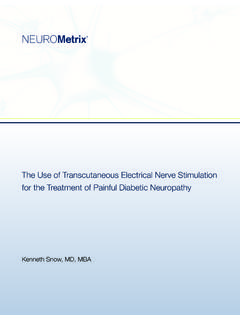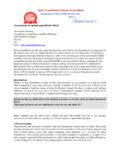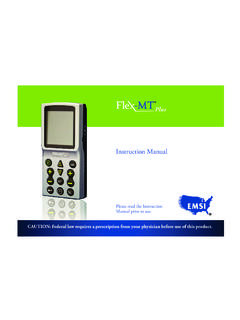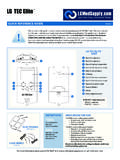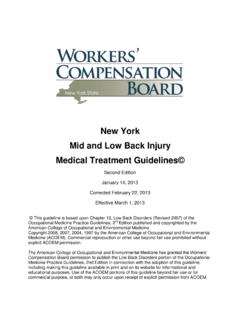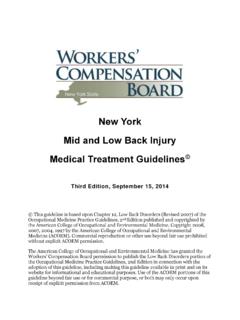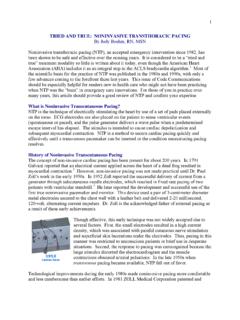Transcription of Treatment of Myofascial Pain Dysfunction Syndrome in an ...
1 43 People s Journal of Scientific ResearchVol. 4(1), Jan. 2011 Treatment of Myofascial pain Dysfunction Syndrome in an Edentulous Patient A Case ReportBenaiffer Agrawal *Kirti SomkuwarDepartment of Prosthodontics, People s Dental Academy, *People s College of Dental Sciences & Research Centre,Bhopal-462037 Abstract: pain is a complex phenomenon, causing discomfort, suffering and psychosocial morbidity. Myofascial PainDysfunction Syndrome (MPDS) is attributed to pain & inflammation of the muscles, with no definitive pathogenesiscausing this Syndrome . The purpose of this paper is to describe the multidisciplinary approach for the Treatment of a 70year old female patient who suffered from myofacial pain Syndrome for the last 10 years.
2 Combined with Trans-cutaneouselectrical nerve stimulation (TENS), the construction of a complete denture in order to re-establish the proper verticaldimension leading to decrease in muscular activity thereby eliminating the underlying cause of disease and providing adefinitive Treatment for the patient with Words: Myofascial pain Syndrome , Temporomandibular Joint, Trans cutaneous electric nerve : pain in facial region originating from bothtemporomandibular joint and jaw muscles is a commonclinical problem. There are many synonyms for thiscondition including Myofascial pain DysfunctionSyndrome (MPDS), Mandibular Dys-functionSyndrome and the Temporomandibular JointDysfunction Syndrome (Edmiston & Larsen, 1978).
3 Signs and symptoms of MPDS vary, but generally, thepatient complains of one or more of the following: - pain in the region of the temporomandibular joints(TMJ), tenderness in the region of one or both joints,temporo-mandibular joint sounds like clicking orcrepitation, restricted jaw opening, disturbed chewingpattern and locking of jaw (Blasberg & Greenburg,2003).Muscle pain is one of the commonest chiefcomplaints of the patient and while it primarily involvesjaw muscles, some times cervical muscles are affectedas well. Headache caused by the muscular tension ofthe jaw muscles is another presenting feature (Lous,1976).
4 The precise cause of MPDS is not fullyunderstood. Postural, emotional and behavioral factorsmay contribute to it (Gerwin, 2004). Consequently,many different therapies including conservative, havebeen advocated for patients with Myofascial pain . Anumber of successful Treatment outcomes have beenreported, including occlusal splints, physiotherapy,muscle-relaxing appliances, and pharmacological------------------------- ---------------------------------------- -----------Corresponding Author: Dr. Benaiffer Agrawal, 38-39, MaheshColony, Eid-Ga-Hills, Convent School Road, Bhopal-462001 Phone No.: +91 9425004621E-mail : Reportinterventions (Al Ani et al, 2005).
5 Inspite of its diverseetiology, occlusal instability has been long consideredan important aetiological factor. In complete denturewearers with mandibular Dysfunction , symptoms oftendisappear after improvement of the occlusion (Carlsson,1976).Trans-cutaneous electrical nerve stimulationhas proven to be useful in many painful on Wall & Melzack s Gate Control Theory andlater improved as trans-cutaneous electrical stimulator,TENS has been used very commonly for pain relief inthe last 30 years (Tarhan et al, 1999). It works bydecreasing pain perception and it may be used to controlacute and chronic report:A 70-year-old female patient was referred byher general dental practitioner to the Department ofProsthodontics, People s College of Dental Sciencesfor Treatment of pain & prosthodontic patient complained of pain on the right side of face,difficulty in eating and opening the mouth for the last10 years.
6 The disease was particula rly severe for last2 months. She also reported pain while talking or movingher jaw, intense unbearable pain was perceived anteriorto the right ear and radiating to the temple region. Shegave a history of being edentulous for last 3 years andwas a non denture wearer. pain was described as beingto the score of nine out of ten on the Visual AnalogueScale (VAS). pain could be elicited in right joint area duringopening and closing the mouth. Using the flat palpation44 People s Journal of Scientific ResearchVol. 4(1), Jan. 2011technique, tenderness was recorded over massetricmuscle which could possibly be termed a myofascialtrigger point (Dommerholt, 1995).
7 Based on symptomsand clinical examination the patient was diagnosed tohave Myofascial pain Dysfunction Syndrome . Inconsultation with an oral physician,a Treatment planwas formulated. Patient was put on pharmacotherapywhich included Chlorzoxazone 500 mg, Paracetamol500mg and Diclofenac potassium 50 mg twice fomentation was recommended twice daily for5-10 minutes and physiotherapy in the form of jawexercises. Trans-cutaneous electrical nerve stimulationtherapy was given by placing skin electrodes in theright pre auricular and massetric muscle region. Thepulse width taken was 60 micro-second.
8 At the pulseFig. I Showing placement of skin electrode: right pre-auricular andmassetric of 80 impulses/ sec. it was given for 15 min. onalternate days for 1 month (Fig. I). Prostheticrehabilitation was done, paying attention to theimpression technique and appropriate designing of theocclusal primary impression of the maxillary denturebearing area was made with a low viscosity irreversiblehydrocolloid material (Alginate; DENTSPLY Ltd, UK),to ensure minimal distortion of the displaceable final impression was then made using Heavy bodiedaddition-curing polyvinylsiloxane (Zhermack clinicalpolyvinylsilo-xane impression material.)
9 Badia Polesine,Italy) impression material which was loaded on thecustom tray and seated in the patient s , the material was used for bordermoulding. The area of the custom tray was then filledwith light bodied polyvinylsiloxane wash of light-bodied polyvinylsiloxaneimpression material was also placed over the heavybodied material that had compressed the normal tissues. This tray was placed in the mouth and allowedto set. Excess material was removed after the materialset. The impression was re-inserted to ensure that itwas retentive and did not rock when pressure wasapplied over the displaceable areas.
10 Propermanipulation ensured so that no overextension impression was cast in dental stone, paying carefulattention to preserving the bordered moulded sulcusarea. A heat-cured acrylic transparent base plate wasfabricated to assess the accuracy of fit of denture base. Denture fabrication was then continued in the usualmanner: Face-bow transfer, re-establishing verticaldimension and arrangement of teeth was done on aFigure II : Showing how facial expression of patient changes with gradual increase of pain and scores given accordingly: No pain 0; pain canbe ignored 1-2; pain interfering with task 3-4; pain interfering with concentration 5-6; interferes with basic needs 7-8 and pain which requirebed rest 9-10.

